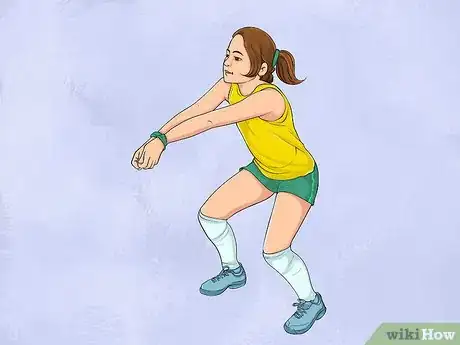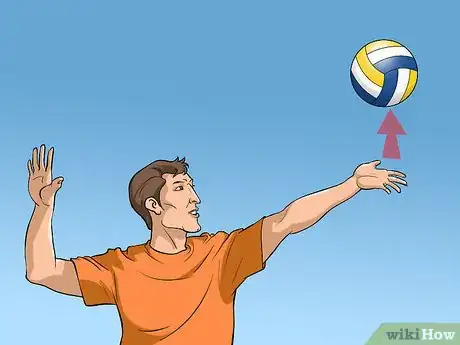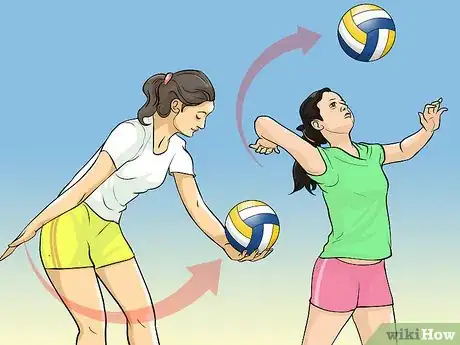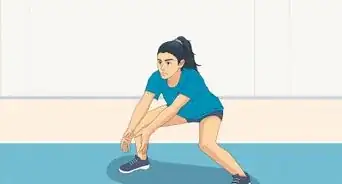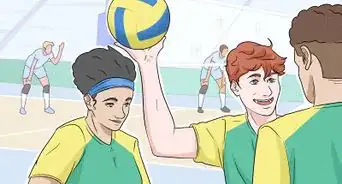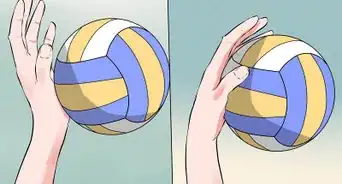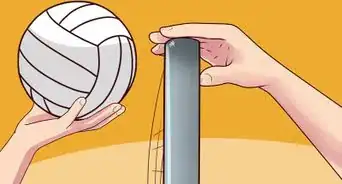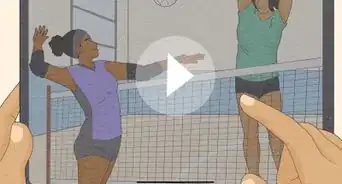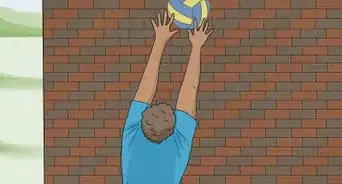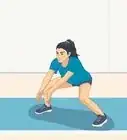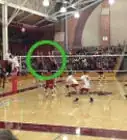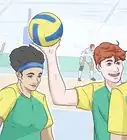This article was co-authored by wikiHow Staff. Our trained team of editors and researchers validate articles for accuracy and comprehensiveness. wikiHow's Content Management Team carefully monitors the work from our editorial staff to ensure that each article is backed by trusted research and meets our high quality standards.
This article has been viewed 128,420 times.
Learn more...
Volleyball is a fun sport for all ages. The sooner kids start playing, the more skilled they will become -- it takes years to master some volleyball skills. Kids are able to learn most volleyball basics, such as passing, serving, and setting. Other skills, such as spiking, might be too complicated for young learners. The key to working with kids is to keep it fun and give lots of encouragement. You can even have parents join in the lesson so that everyone has fun.
Steps
Passing
-
1Teach proper hand placement. Have them place one hand flat, place their other hand underneath that hand, and curl in their thumbs to the middle of their hands. Their forearms should form a flat surface, which is where the ball will be hit.[1]
- Alternately, they can make a fist with their left hand and then cover the fist with their right hand so that their thumbs line up on top.
- They should never interlock their fingers because it is dangerous and they could end up with a broken finger.
-
2Show the kids a proper stance. They should stand with their feet slightly more than shoulder-width apart and their knees bent. Have them practice squatting as if they were sitting in a chair.[2]
- They should be light on their feet so that they can move and get to any ball. To help develop this agility, you can have them shuffle laterally from one side of the court to the other.
Advertisement -
3Have the kids practice passing. The kids can stand in pairs and practice throwing the ball to one another. The ball should be thrown underhand to the other kid’s arms. The ball will be hit with their forearms back to the other kid. This is known as bumping the ball. Have them do this until they get used to the feel of hitting the ball on the proper surface.
- One kid can hit the ball 10 times and then the other can hit the ball 10 times.
-
4Play passing games. You can then start moving around and making fun games out of it. For example, the ball can be thrown towards alternating sides of the child instead of directly at their arms. You could give them a point each time the child who threw the ball is able to catch the ball that was hit back towards them. The team with the most points at the end of a minute wins!
Serving
-
1Show them how to toss the ball. With their non-hitting hand, kids should toss the ball in the air slightly in front of them. Their tossing hand shouldn’t move too much and the ball shouldn’t go too high. If the ball is thrown very high, then it will be moving faster and more difficult to hit. Aim for about 2ft (.6m) above the head and about 2ft (.6m) in front of them.[3]
- The key to a good serve is to keep it simple. It should all be one smooth, fluid movement.
-
2Teach them to step towards the ball. Kids need to take a large step forward in the direction that they wish to hit the ball. This will help them to generate enough power to hit the ball over the net. They should step forward with the foot on the same side as their hitting hand.[4]
-
3Have them make contact with the ball. Their hitting arm should be extended above their head and they should hit the ball with the heel of their hand. This will help the ball to go the furthest without spinning. The arm should follow through after hitting the ball until the hand is down by their thigh.[5]
- The hand should be completely open when hitting the ball.
- The ball should be hit as it is descending from its toss. The kids should reach up towards the ball to make sure their arm is fully extended.
-
4Have them practice serving. They can stand several feet away from a wall and practice serving the ball against the wall. They can form pairs with one child on each side of the net and practice hitting it over. The key to getting a good serve is lots and lots of practice.[6]
- The toss, step, and hit should all happen in one fluid motion.
- Some kids won't be able to serve across the full court. You can have them stand closer to the net so that they can practice hitting the ball over.
-
5Teach an underhand serve if they aren’t able to do an overhand serve. To serve the ball underhand, they can toss the ball and step forward, but they will move their hitting hand down by their side and then swing it forward instead raising it up in the air. They will hit the ball over the net with their fist. This method is the easiest for making contact with the ball.[7]
- An underhand serve is easier for younger players, but they should still be practicing the overhand serve so that they can learn it and be able to do it eventually.
Setting
-
1Teach proper hand placement. When setting the ball, kids should start with both hands hovering right over their forehead. The thumbs and pointer fingers should form a triangle and the palms should face outward. The elbows should be out to the side in a wide position, which will provide leverage to push the ball. They will then push their hands upward to set the ball.[8]
- The key is for the hands to make contact with the ball when it is right at their foreheads and for all 10 fingers to touch the ball.
-
2Have them practice catching the ball. They can toss the ball up to themselves and catch it right above their forehead with their hands in the setting position. Their fingers should wrap around the ball. This will help them get used to the setting position.[9]
- This drill can be done seated so that kids don’t worry about foot placement.
-
3Have them practice pushing the ball upwards. You can divide the kids into pairs. One child can toss the ball to themselves and then instead of catching it, they will set it to the other kid. They should push the ball upwards, straightening their arms into parallel lines in one smooth, direct motion. The other kid should be about 5 feet (or 1.5m) away and they will catch the ball.[10]
- The child setting the ball can remain seated and the other child can stand and catch the ball and return it to their partner. After 10 times, they can switch turns.
- To make this drill more difficult, increase the distance between the kids by having them take a large step backwards. To set the ball further, they will need to push their arms more diagonally rather than straight up. You can increase the distance so that the kids are up to 10ft (about 3m) apart total.
Community Q&A
-
QuestionHow do you do overhand?
 DonaganTop AnswererIf you're asking about an overhand serve, you throw the ball into the air and then hit it hard with your palm. See How to Serve a Volleyball Overhand. It can take a while to get the hang of it, and some people (especially children) may not be strong enough or coordinated enough to do an overhand serve successfully.
DonaganTop AnswererIf you're asking about an overhand serve, you throw the ball into the air and then hit it hard with your palm. See How to Serve a Volleyball Overhand. It can take a while to get the hang of it, and some people (especially children) may not be strong enough or coordinated enough to do an overhand serve successfully. -
QuestionWhy do you need knee pads?
 Community AnswerBecause sometimes you have to fall on your knees to hit the ball when it's too low to reach standing up. Knee pads protect your knees from getting hurt when you do that.
Community AnswerBecause sometimes you have to fall on your knees to hit the ball when it's too low to reach standing up. Knee pads protect your knees from getting hurt when you do that. -
QuestionWhat is the best way to teach them to perform an underhand serve?
 Community AnswerTeach them by first asking them to close their fist and hit the underside of the ball. Then, slowly have them open their fist.
Community AnswerTeach them by first asking them to close their fist and hit the underside of the ball. Then, slowly have them open their fist.
Warnings
- Kids should never interlock their fingers when bumping the ball because it can cause them to break!⧼thumbs_response⧽
References
- ↑ http://iml.jou.ufl.edu/projects/Fall08/Devine/passing.html
- ↑ http://iml.jou.ufl.edu/projects/Fall08/Devine/passing.html
- ↑ https://www.goldmedalsquared.com/blog/serving-teaching-the-young-kids/
- ↑ https://www.goldmedalsquared.com/blog/serving-teaching-the-young-kids/
- ↑ https://www.goldmedalsquared.com/blog/serving-teaching-the-young-kids/
- ↑ https://www.goldmedalsquared.com/blog/serving-teaching-the-young-kids/
- ↑ https://www.goldmedalsquared.com/blog/serving-teaching-the-young-kids/
- ↑ http://www.theartofcoachingvolleyball.com/setting-teaching-the-fundamentals-to-a-young-player/
- ↑ http://www.theartofcoachingvolleyball.com/setting-teaching-the-fundamentals-to-a-young-player/
About This Article
To teach volleyball to kids, start by showing them proper hand placement with one hand over the other, and make sure they don’t interlock their fingers, since that can lead to broken bones. Then, demonstrate proper stance with their feet just over shoulder-width apart. Once their stance and hand placement are correct, have the kids practice passing in pairs by hitting the ball with their forearms. To make a game of it, encourage them to see how many times they can hit the ball back and forth before it falls to the ground! For more tips, such as teaching serving and setting, keep reading!

